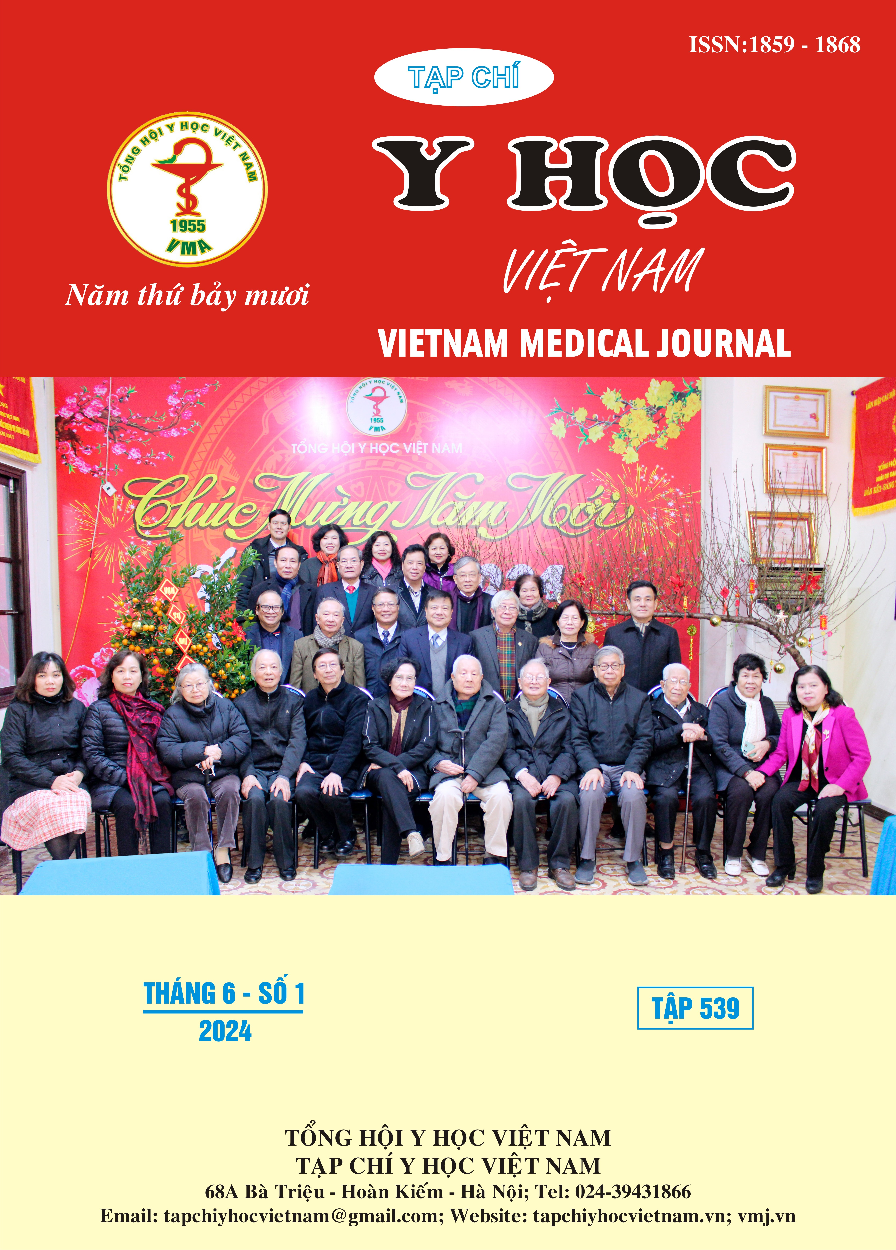CHARACTERISTICS OF DYSLIPIDEMIA IN CHILDREN WITH NEPHROTIC SYNDROME AT CHILDREN HOSPITAL 1
Main Article Content
Abstract
Introduction: Nephrotic syndrome (NS) is the most common glomerular disease in children. There are several complications of this disease, one of which is dyslipidemia. In Viet Nam, there is only one research about dyslipidemia in children with Steroid – resistant NS. Method: We performed a cross – sectional study of 126 children with NS at Children Hospital 1 from November 2022 to June 2023. Diagnotic criteria include 24-hour proteinuria > 50 mg/kg or uPCR > 200 mg/mmol. Elimination criteria include: (1) children with additional glomerular disease such as IgA nephropathy, SLE, glomerulonephritis due to infection or autoimmune; (2) children with familial dyslipidemia. A fasting lipid profile is performed by taking the first blood sample in the morning, ensuring that the child fasts for 8 hours by instructing their parents the night before. Cutoff points are used to categorize lipid values are based on the guidelines of the American Academy of Pediatrics. Results: In 126 children, there were 23 newly diagnosed cases and 103 cases under treatment; there were 93 male and 33 female, mean age at first diagnosis was 5,8 ± 3,9 years old; there were 70 cases that get kidney biopsy with 49 MCD (70,0%) and 21 FSGS (30,0%). In the children who were under treatment, the average time of using Steroid was 4,3 ± 4,0 years; there were 35 Steroid – sensitive cases (34,0%), 60 Steroid – resistant cases (58,2%) and 8 Calcineurin (CsA) – resistant cases (7,8%); there were 48 remission cases (46,6%) and 55 cases of no remission (53,4%). Mean level of categories in bilan lipid in the study group were higher than normal values, details: TC 10,9 ± 5,6 mmol/L, TG 3,6 ± 2,8 mmol/L, LDL-C 7,3 ± 4,4 mmol/L, HDL-C 2,0 ± 0,7 mmol/L. These levels in the remission cases decreased significantly, however they were still higher than normal values: TC 6,8 ± 3,6 mmol/L, TG 2,5 ± 1,4 mmol/L, LDL-C 4,1 ± 2,9 mmol/L, HDL-C 1,6 ± 0,6 mmol/L. Hypercholesterolemia rate in no remission cases was 92,7%, significantly higher than 60,4% in remission group (P < 0,01). Elevated LDL-C rate in no remission cases was 90,9%, significantly higher than 43,8% in remission group (P < 0,01). There were no differences about hypertriglyceridemia ratio between remission group and no remission group. Average plasma albumin level in children with hypercholesterolemia; hypertriglyceridemia; elevated LDL-C compared to children with a normal lipid profile was sequentially 2,2 ± 1,1 g/dl and 3,8 ± 0,8 g/dl (P < 0,01); 2,3 ± 1,2 g/dl and 3,5 ± 0,8 g/dl (P < 0,01); 2,0 ± 1,0 g/dl and 3,8 ± 0,7 g/dl (P < 0,01). Conclusion: In children with NS, all categories in bilan lipid increased, including HDL-C. In children with remission, these levels decreased significantly, however they were still higher than normal values. The common types of dyslipidemia in children with NS were hypercholesterolemia and elevated LDL-C. Clinical and sub-clinical factors that affect dyslipidemia were edema degree, proteinuria degree, albumin level and level of treatment response.
Article Details
Keywords
Nephrotic syndrome, dyslipidemia
References
2. Nguyễn Đức Quang (2020). "Hội chứng thận hư trẻ em". Phác đồ điều trị nhi khoa 2020, Bệnh viện Nhi Đồng 1, Nhà xuất bản Y Học TP.HCM, pp. 836-847.
3. American Academy of Pediatrics, Guideline Pediatrics Practice (2012). "Expert Panel on Integrated Pediatric Guideline for Cardiovascular Health and Risk Reduction". Pediatrics, 129 (4), pp. e1111.
4. Dnyanesh DK et al (2014). "A Study of Serum Lipids in Nephrotic Syndrome in Children". IOSR Journal of Dental and Medical Sciences, 13 (3), pp. 1-6.
5. Indumati V, Krishnaswamy D, Satishkumar D, et al. (2011). "Serum proteins, initial and follow-up lipid profile in children with nephrotic syndrome". International Journal of Applied Biology and Pharmaceutical Technology, 2 (3), pp. 59-63.
6. Kari JA et al (2012). "lipoprotein (a) and other dyslipidemia in Saudi children with nephrotic syndrome". Journal of Health Science, 2 (6), pp. 57-63.
7. Mérouani A, Lévy E, Mongeau JG, et al. (2003). "Hyperlipidemic profiles during remission in childhood idiopathic nephrotic syndrome". Clinical Biochemistry, 36 (7), pp. 571-574.
8. Screenivasa B, Sunil Kumar P, Suresh Babu M.T, et al. (2015). "serum lipid profiles during onset and remission of steroid sensitive nephrotic syndrome in children". BMR Medicine,1 (1), pp. 1-4.


